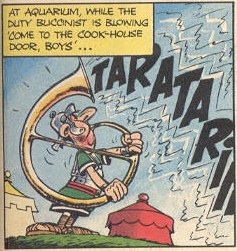I listened to "The Pines of Rome" at work this week for the first time in many years. Parts of it made me wonder.
About 8 to 9 minutes into it, maybe in the second section, I hear what sounds like blues riffs in strings. I think they could be in fifths even, It sounds so much like how we would expect an orchestra backing a pop band today would sound - very familiar. But this must have been a radical and strange sound in the 20's or 30's or whenever it was written. I know the blues ostinato was just a coindcidence if I'm even hearing it correctly.
I'm also curious if they used bird recordings when this was first performed. They couldn't have had the recording capabilities we have today, so are the current performances better now? When this piece is recorded, does the mixer put the birds in after the fact or re-record the recording of them? It's a very gray area isn't it?
I need to listen to the other two of the rome trilogy, but I only know of "The Fountains - ."
I'll have to look up the the other piece.
I think the Ancient Airs and Dances suites are my favorites that I have heard from Respighi, probably because I love baroque so much, and these are like baroque on steroids.
He was a great orchestral colorist. I'm not sure any twentieth century composer surpassed him in that department.
About 8 to 9 minutes into it, maybe in the second section, I hear what sounds like blues riffs in strings. I think they could be in fifths even, It sounds so much like how we would expect an orchestra backing a pop band today would sound - very familiar. But this must have been a radical and strange sound in the 20's or 30's or whenever it was written. I know the blues ostinato was just a coindcidence if I'm even hearing it correctly.
I'm also curious if they used bird recordings when this was first performed. They couldn't have had the recording capabilities we have today, so are the current performances better now? When this piece is recorded, does the mixer put the birds in after the fact or re-record the recording of them? It's a very gray area isn't it?
I need to listen to the other two of the rome trilogy, but I only know of "The Fountains - ."
I'll have to look up the the other piece.
I think the Ancient Airs and Dances suites are my favorites that I have heard from Respighi, probably because I love baroque so much, and these are like baroque on steroids.
He was a great orchestral colorist. I'm not sure any twentieth century composer surpassed him in that department.









